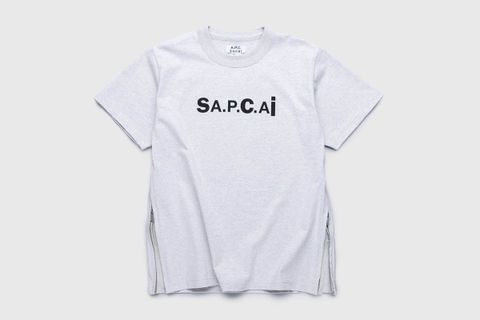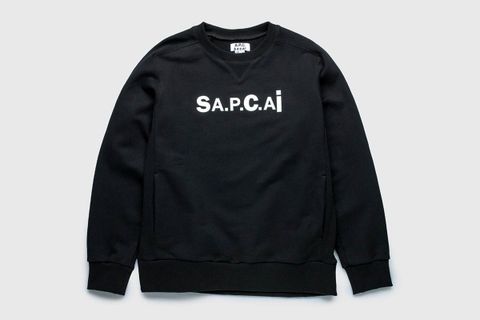A.P.C.’s Jean Touitou Wants To Clear Up a Few Things About Selvedge Denim
A.P.C. has been known to get into bed with an eclectic group of collaborators: Kanye West, JJJJound, iconic French actress Catherine Deneuve, Nike, Carhartt WIP, and Kid Cudi among them. Perhaps there's something about A.P.C. that just lends itself to having a dialogue? Or perhaps it's the forthcoming nature of its founder, Jean Touitou.
Next up for A.P.C.'s "interactions" roster is sacai, Chitose Abe's label that's best known – at least among younger audiences – for doubling down on Swooshes and soles for the wildly successful Nike Vaporwaffle collaborations. However, sacai has been developing a cult fan base for those who appreciate hybridized clothing since its inception in 1999. Much like A.P.C., sacai has a good understanding of who its customer is and why they shop in their stores.
Below, we chat with A.P.C.'s Touitou who explains, with characteristic outspokenness, how the de facto French minimalist brand and voluminous Japanese label sacai found a common ground for their collaboration.
Why sacai?
It was purely "accidental." Sarah Andelman got in touch and asked if we could provide sacai with some denim jackets for them to customize for a one-off shoot. It was sold in their Paris pop-up two years ago. We said yes, and loved what they came up with. The idea of working together again came up quite naturally after that.
A.P.C. is rooted in simplicity while sacai is better known for its volume and complexity. How did you find a shared design language for the brands to collaborate?
You’re right. It may appear quite counterintuitive to even think that the two brands could play together. But, there is apparently a contradiction here, and I will try to explain that in fact there is not.
Most importantly, there are elective affinities between us. As we spoke during our first meeting, I soon realized that A.P.C.’s history in Japan made them simply appreciate us. We took them to my son’s restaurant one night, and they went back to it three nights in a row. I know this doesn’t answer your question at all, but it gives some idea on feeling close together. Of our 35 years of trips to Tokyo, I had never been invited to a dinner party. Except by Chitose, who promised to cook for us when travel will be possible.
My real answer to your question is this: we do the same job, we work in the same industry. It just happens that the way Chitose sees her art is a different approach from ours. It’s as if one musician decides to play three bars-blues to express himself, and another one decides to choose R&B. I mean, there are structural resemblances in any piece of clothes: two legs in a pant, two arms in a jacket, etc. When we received their patterns for the first prototypes to be made in our atelier in Paris, no one there screamed and said "what is that, we can’t understand." We just did the prototypes, which goes to show that we speak the same language.
Lastly, I would like to stress one thing: simplicity is at least as demanding as complexity when it comes to making a garment. One is naked when one presents a jacket that is just a jacket, so any technical weakness appears very loudly. There is no distraction for the eye. Sometimes complicated ornamentation is like a pretentious French sauce on some poor quality piece of food. For example, if you just think about a sleeve, it’s one circle part stitched together with a smaller circle. Think about it... how do you do that?
What was the process of the collaboration?
Interactions with creatives. We speak, we look at drawings, we challenge ourselves with questions, we organize fittings, alter them, start again, fit again.
There’s a quote from Raf Simons that I’m often thinking about: “Fashion has become pop, and the winners are the ones who scream the hardest, not the ones who speak the most intelligently.” Do you agree, and do you think being “the winner” is a good priority for a fashion brand?
I totally agree. And the more pop you go, the more frustration you have to experience. I think sometimes it’s more respectful to be a beautiful loser than an ugly winner. But, you have to consider that during this endless pandemic, it sometimes could be necessary to go a little bit more pop than I would have wanted. And hey, at the end of the day, we survived. I would like to add that sometimes going more pop could bring huge satisfaction too. After John Cale was "fired" from The Velvet Underground it was sad, but, it also gave birth to a lot of incredibly melodic songs.
What is it about selvedge denim that you like? What’s your relationship to the fabric?
Listen, so much stupidity has been spread around about this selvedge business, so I’ll try to be clear: By nature every fabric has a selvedge, otherwise it would not hold itself together. It would be like a car with no wheel. What I care about for structural reasons, is to have a narrow width denim — eventually with a red selvedge — because it prevents the leg stitching to twist. It brings dignity to the piece. I won’t elaborate. It would need a little sketch.
My relationship to the fabric? Some fabrics talk to me, and when they don’t I just avoid them. I feel like a historian trying to analyze a document from the past. I question it and see the whole humanity in it. In a way that a fabric does tell a story, which might be the definition of what only humans can do.
In its earlier years, A.P.C. had a large female customer base shopping the menswear lines.
True.
This suggests that fashion has been openly genderless well before it was a buzzword.
Indeed, yes.
What do you think of the idea of genderless or unisex fashion now?
Frankly, I don’t mind it. This is what I have done for 35 years. And this is what we did with SA.P.C.AI.
Which of the new pieces do you think best encapsulates the spirit of both A.P.C. and sacai?
Maybe the jacket and the jeans. WE ARE THE NEW CANADIAN TUXEDO.









